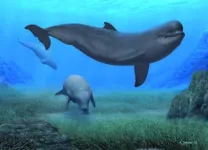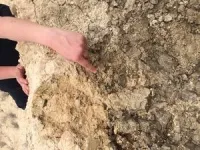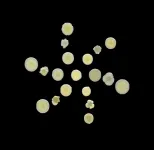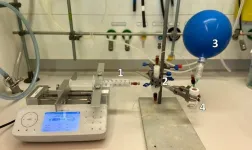(Press-News.org) A new study paves the way to understanding biotic recovery after an ecological crisis in the Mediterranean Sea about 5.5 million years ago. An international team led by Konstantina Agiadi from the University of Vienna has now been able to quantify how marine biota was impacted by the salinization of the Mediterranean: Only 11 percent of the endemic species survived the crisis, and the biodiversity did not recover for at least another 1.7 million years. The study was just published in the renowned journal Science.
Lithospheric movements throughout Earth history have repeatedly led to the isolation of regional seas from the world ocean and to the massive accumulations of salt. Salt giants of thousands of cubic kilometers have been found by geologists in Europe, Australia, Siberia, the Middle East, and elsewhere. These salt accumulations present valuable natural resources and have been exploited from antiquity until today in mines around the world (e.g. at the Hallstatt mine in Austria or the Khewra Salt Mine in Pakistan).
The Mediterranean salt giant is a kilometer-thick layer of salt beneath the Mediterranean Sea, which was first discovered in the early 1970s. It formed about 5.5 million years ago because of the disconnection from the Atlantic during the Messinian Salinity Crisis. In a study published in the journal Science, an international team of researchers – comprising 29 scientists from 25 institutes across Europe – led by Konstantina Agiadi from University of Vienna now was able to quantify the loss of biodiversity in the Mediterranean Sea due to the Messinian crisis and the biotic recovery afterwards.
Huge impact on marine biodiversity
After several decades of painstaking research on fossils dated from 12 to 3.6 million years found on land in the peri-Mediterranean countries and in deep-sea sediment cores, the team found that almost 67% of the marine species in the Mediterranean Sea after the crisis were different than those before the crisis. Only 86 of 779 endemic species (living exclusively in the Mediterranean before the crisis) survived the enormous change in living conditions after the separation from the Atlantic. The change in the configuration of the gateways, which led to the formation of the salt giant itself, resulted in abrupt salinity and temperature fluctuations, but also changed the migration pathways of marine organisms, the flow of larvae and plankton and disrupted central processes of the ecosystem. Due to these changes, a large proportion of the Mediterranean inhabitants of that time, such as tropical reef-building corals, died out. After the reconnection to the Atlantic and the invasion of new species like the Great White shark and oceanic dolphins, Mediterranean marine biodiversity presented a novel pattern, with the number of species decreasing from west to east, as it does today.
Recovery took longer than expected
Because peripheral seas like the Mediterranean are important biodiversity hotspots, it was very likely that the formation of salt giants throughout geologic history had a great impact, but it hadn’t been quantified up to now. “Our study now provides the first statistical analysis of such a major ecological crisis”, explains Konstantina Agiadi from the Department of Geology. Furthermore, it also quantifies for the first time the timescales of recovery after a marine environmental crisis, which is actually much longer than expected: “The biodiversity in terms of number of species only recovered after more than 1.7 million years,” says the geoscientist. The methods used in the study also provide a model connecting plate tectonics, the birth and death of the oceans, Salt, and marine Life that could be applied to other regions of the world.
“The results open a bunch of new exciting questions,” states Daniel García-Castellanos from Geosciences Barcelona (CSIC), who is the senior author of this study: “How and where did 11% of the species survive the salinization of the Mediterranean? How did previous, larger salt formations change the ecosystems and the Earth System?” These questions are still to be explored, for instance also within the new Cost Action Network “SaltAges” starting in October, where researchers are invited to explore the social, biological and climatic impacts of salt ages.
Video Content
This video is a recreation of one of the proposed models for how the Mediterranean was isolated by the sinking of a lithospheric plate into the Earth’s mantle (approx. 6 million years ago) and how dry climate then lead to the desiccation of that sea during the Messinian Salinity Crisis (approx. 5.5 million years ago), until 5.33 million years ago, the level of the Atlantic exceeded that of the Gibraltar land bridge and triggered a fast refill (see also http://retosterricolas.blogspot.com/2011/12/messinian-salinity-crisis-33-causes-and.html). © CSIC - Daniel García-Castellanos
END
How a salt giant radically reshaped Mediterranean marine biodiversity
First quantification of a major ecological crisis and recovery
2024-08-29
ELSE PRESS RELEASES FROM THIS DATE:
Bacteria able to overcome cost of vancomycin resistance in lab setting
2024-08-29
Staphylococcus aureus has the potential to develop durable vancomycin resistance, according to a study published August 28, 2024, in the open-access journal PLOS Pathogens by Samuel Blechman and Erik Wright from the University of Pittsburgh, USA.
Despite decades of widespread treatment with the antibiotic vancomycin, vancomycin resistance among the bacterium S. aureus is extremely uncommon—only 16 such cases have reported in the U.S. to date. Vancomycin resistance mutations enable bacteria to grow in the presence of vancomycin, but they do so at a cost. Vancomycin-resistant S. aureus (VRSA) strains grow more slowly and will often lose their resistance mutations if vancomycin ...
Wearable “smart mask” monitors disease by capturing and analyzing exhaled breaths
2024-08-29
A person’s exhaled breath – which provides information that could unveil diverse health insights – has been hard to analyze. Now, a novel “smart mask” provides real-time, non-invasive monitoring of what people exhale. The mask, dubbed EBCare, captures and analyzes exhaled breath condensate (EBC), and it offers a promising solution for continuous EBC analysis at an affordable cost. “The significance of EBCare lies in its role as a versatile, convenient, efficient, real-time research platform and solution in various medical domains, ...
Cultural traditions, not genetics or environment, inform nest architecture among white-browed sparrow weaver birds
2024-08-29
Challenging long-held beliefs that bird nest building is solely influenced by genetics or the environment, researchers report that the white-browed sparrow weavers of the Kalahari Desert, Africa, build nests with distinct architectural styles that reflect group-specific cultural traditions. “Behavioral traditions in birds have been well documented for song, migration, foraging, and tool use. Here, we add building behavior and show that architectural styles emerge from birds that build together,” write the ...
Oxidative damage riggers micronuclear collapse mechanisms in cancer, two studies report
2024-08-29
Reactive oxygen species (ROS) from mitochondria are key drivers of genetic chaos in cancer by causing the collapse of micronuclear envelopes, a process that fuels the chromosomal instability (CIN) often observed in aggressive tumor behavior. These are the findings of two new studies. The findings identify key proteins in this destructive process – p62 and CHMP7 – revealing potential prognostic markers and therapeutic targets for high-CIN tumors. Errors in chromosome segregation during cell division can lead to chromosomal instability, a key feature of cancer. These errors result in the formation of micronuclei, which are small structures ...
Messinian salinity crisis nearly reset Mediterranean biodiversity
2024-08-29
A meta-analysis of Mediterranean Sea marine species reveals the profound impact of the Messinian Salinity Crisis – a drastic environmental event that resulted in the almost complete evaporation of the Mediterranean Sea roughly 5.5 million years ago. According to the new study’s findings, the event nearly reset the region’s biodiversity. The findings offer novel insights linking tectonic and palaeoceanographic changes to marine biodiversity, highlighting the significant role of salt giants in shaping biogeographic patterns, including those that still influence ecosystems today. The Messinian Salinity Crisis (MSC), ...
Uncovering the secret communication of monkeys: They have names!
2024-08-29
New study from Hebrew University reveals that marmoset monkeys use specific calls, known as "phee-calls," to name each other, a behavior previously known to exist only in humans, dolphins, and elephants. This discovery highlights the complexity of social communication in marmosets and suggests that their ability to vocally label each other may provide valuable insights into the evolution of human language.
LINK to pictures https://drive.google.com/drive/folders/1VjzO-70hk27UVX_IuQ6FTsHgmCgk9PCH?usp=drive_link
Credit for pictures and sound: David Omer Lab
In a groundbreaking discovery, researchers from Hebrew ...
Smart mask monitors breath for signs of health
2024-08-29
Personalized wearable devices that monitor people's health are on the rise. From watches to patches and other types of sensors, these smart devices can monitor heart activity, inflammation levels, and more to help patients better manage their health from their own homes. Now, a new type of wearable device can be added to the list: a high-tech paper mask that monitors one's breath.
Caltech's Wei Gao, professor of medical engineering, and his colleagues have developed a ...
Mechanisms of how morphine relieves pain mapped out
2024-08-29
In a study published in Science, researchers at Karolinska Institutet describe the neural processes behind how morphine relieves pain. This is valuable knowledge because the drug has such serious side effects.
Morphine is a powerful painkiller that belongs to the group of opioids. It blocks signals in the pain pathways and also increases feelings of pleasure.
Morphine acts on several central and peripheral pain pathways in the body, but the neural processes behind the pain relief have not previously been fully understood.
Researchers have now investigated how morphine relieves pain using ...
PFAS-free synthesis of fluorinated pharmaceutical and agrochemical compounds
2024-08-29
Chemists at the University of Amsterdam have developed a method to furnish a range of molecules with a trifluoromethyl group attached to a sulphur, nitrogen or oxygen atom. Their procedure, which has just been published in Science, avoids the use of PFAS reagents. It thus provides an environmentally friendly synthesis route for pharmaceutical and agrochemical compounds that rely on the presence of the trifluoromethyl group.
The straightforward and effective method was developed at the Flow Chemistry group at the Van ‘t Hoff Institute for Molecular Sciences ...
School of Dentistry researchers develop innovative sleep apnea model to find answers to chronic pain
2024-08-29
Scientists at The University of Texas Health Science Center at San Antonio (UT Health San Antonio) School of Dentistry created a first of its kind sleep apnea model for studying chronic pain. A study published July 30 in Science Signaling, explains the mechanism behind persistent pain related to obstructive sleep apnea.
More than 100 million people worldwide are affected by obstructive sleep apnea. This health condition causes a person to stop breathing numerous times while they are sleeping. Reduced sleep time and sleep quality can lead to numerous health problems including chronic pain, which is diagnosed at a much higher rate ...
LAST 30 PRESS RELEASES:
New study shows how the spleen helps the immune system accept a transplant
New Mayo Clinic study advances personalized prostate cancer education with an EHR-integrated AI agent
Researchers identify novel therapeutic target to improve recovery after nerve injury
Microbes in breast milk help populate infant gut microbiomes
Reprogramming immunity to rewrite the story of Type 1 diabetes
New tool narrows the search for ideal material structures
Artificial saliva containing sugarcane protein helps protect the teeth of patients with head and neck cancer
Understanding the role of linear ubiquitination in T-tubule biogenesis
Researchers identify urban atmosphere as primary reservoir of microplastics
World’s oldest arrow poison – 60,000-year-old traces reveal early advanced hunting techniques
Bristol scientists discover early sponges were soft
New study uncovers how rice viruses manipulate plant defenses to protect insect vectors
NSF–DOE Vera C. Rubin Observatory spots record-breaking asteroid in pre-survey observations
Ribosomal engineering creates “super-probiotic” bacteria
This self-powered eye tracker harnesses energy from blinking and is as comfortable as everyday glasses
Adverse prenatal exposures linked to higher rates of mental health issues, brain changes in adolescents
Restoring mitochondria shows promise for treating chronic nerve pain
Nature study identifies a molecular switch that controls transitions between single-celled and multicellular forms
USU chemists' CRISPR discovery could lead to single diagnostic test for COVID, flu, RSV
Early hominins from Morocco reveal an African lineage near the root of Homo sapiens
Small chimps, big risks: What chimps show us about our own behavior
We finally know how the most common types of planets are created
Thirty-year risk of cardiovascular disease among healthy women according to clinical thresholds of lipoprotein(a)
Yoga for opioid withdrawal and autonomic regulation
Gene therapy ‘switch’ may offer non-addictive pain relief
Study shows your genes determine how fast your DNA mutates with age
Common brain parasite can infect your immune cells. Here's why that's probably OK
International experts connect infections and aging through cellular senescence
An AI–DFT integrated framework accelerates materials discovery and design
Twist to reshape, shift to transform: Bilayer structure enables multifunctional imaging
[Press-News.org] How a salt giant radically reshaped Mediterranean marine biodiversityFirst quantification of a major ecological crisis and recovery







